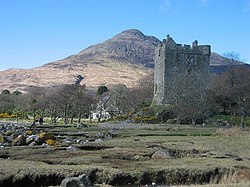| Clan Maclaine of Lochbuie | |||
|---|---|---|---|
| MacGhille Eoin [1] | |||
 | |||
| Motto | Vincere vel mori (To conquer or die) [1] | ||
| Profile | |||
| Region | Scottish Highlands | ||
| District | Lochbuie, Mull | ||
| Plant badge | Blackberry [1] | ||
| Pipe music | Lament for MacLaine of Lochbuie [1] | ||
| Chief | |||
| The Much Honoured Lorne Gillean Ian McLaine of Lochbuie, Baron of Moy | |||
| 26th Chief of Clan Maclaine of Lochbuie | |||
| Historic seat | Moy Castle | ||
| |||
| |||
Clan Maclaine of Lochbuie is a Scottish Clan that inhabited lands on the southern end of the Isle of Mull in the Inner Hebrides of the western Scottish Highlands. "Maclaine" is an alternate spelling for "MacLean." Clan Maclaine of Lochbuie and Clan Maclean of Duart are two separate clans which share a strong family connection. The 26th (and current) clan chief is Lorne Gillean Ian Maclaine of Lochbuie, Baron of Moy. [2] [3] The clan is recognised by both the Standing Council of Scottish Chiefs and the Lord Lyon.
